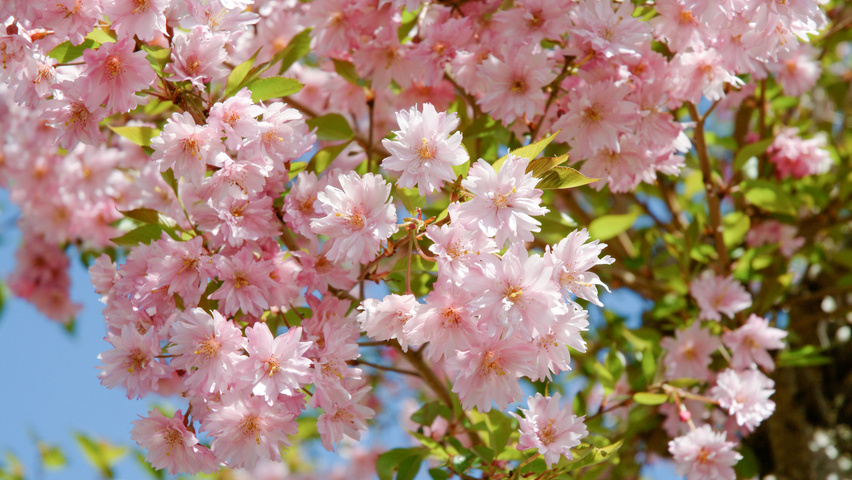Prunus Fukubana
£380.00
Frequently Bought Together



Description
Quick Facts
- Common Name: Fukubana Cherry
- Botanical Name: Prunus incisa ‘Fukubana’
- Plant Type: Deciduous tree
- Mature Height: 4-6m
- Mature Spread: 3-4m
- Flowering Period: March to April
- Flower Colour: Deep rose-pink semi-double flowers
- Foliage: Small serrated leaves, bronze emerging, turning green then orange-red in autumn
- Hardiness: RHS H6 (hardy)
- Soil Requirements: Moist, well-drained, tolerates most soil types
- Aspect: Full sun to partial shade
- Maintenance: Low
Description
Experience the enchanting beauty of Prunus ‘Fukubana’, a delightful compact flowering cherry that brings abundant spring colour and graceful presence to gardens where space is limited but impact is essential. This outstanding ornamental cherry offers exceptional beauty in a manageable size—masses of deep rose-pink semi-double flowers that smother the branches in early spring, creating a spectacular display of colour and romance, combined with attractive bronze-tinted emerging foliage, reliable autumn colour, and a naturally elegant compact form perfect for smaller gardens, courtyard settings, and container growing.
In early spring, this captivating tree becomes completely adorned with abundant semi-double flowers in rich shades of deep rose-pink, each bloom measuring 2-3cm across and arranged in generous clusters along the branches. The flowers emerge from darker pink buds, creating beautiful tonal depth, and appear alongside bronze-tinted young leaves that enhance the richness of the pink blossoms. The profusion of blooms creates a spectacular cloud of colour that transforms the tree into a focal point of spring beauty. As the flowers fade, the foliage matures to fresh green with finely serrated edges, providing elegant presence throughout summer before transforming into warm shades of orange, red, and bronze in autumn. The smooth grey-brown bark adds winter interest.
The name ‘Fukubana’ translates as ‘rich flower’ in Japanese, perfectly describing this cultivar’s abundant and intensely coloured blooms. This remarkable variety is a selection of Prunus incisa, the Fuji Cherry, known for its compact size and exceptional floral display. Perfectly suited to British conditions, ‘Fukubana’ thrives in our temperate climate, tolerating a range of soil types and situations whilst delivering spectacular spring displays year after year. The compact size makes this ideal for modern gardens where space is precious.
Create stunning compositions by planting as specimen trees in small gardens, front gardens, or courtyard settings where the spring blossom can be fully appreciated. Magnificent in large containers on patios and terraces for bringing spring colour close to the house, in mixed borders as focal points, or in groups for naturalistic plantings. Works beautifully underplanted with spring bulbs—pink tulips, white daffodils, and purple crocuses—that complement the rose-pink flowers, or combined with other compact spring-flowering trees and shrubs for extended seasonal displays.
Caragh Garden Notebook
Planting: Space trees 4-5m apart for groupings, or allow 5-6m for specimen placement to accommodate mature spread. Plant bare-root trees from November to March, or container-grown specimens year-round (autumn or early spring is ideal). Dig holes twice the width of the root ball and incorporate organic matter. Plant at the same depth as the nursery soil mark, ensuring the graft union is above soil level. Stake for the first 2-3 years. Water thoroughly and mulch around the base.
Soil Preparation: Thrives in moist, well-drained soil with pH 6.0-7.5. Tolerates a wide range of soil types including clay and sandy loams. Prefers moisture-retentive conditions enriched with organic matter. Avoid waterlogged sites and very shallow chalky soils. Incorporate well-rotted compost or manure to improve soil structure. Best flowering occurs in full sun with good air circulation to reduce disease pressure.
Container Growing: Excellent for large containers (minimum 60-80cm diameter) using soil-based compost. The compact size makes this one of the best flowering cherries for long-term container growing. Water regularly during growing season, especially when in flower and during dry spells. Feed in spring with slow-release balanced fertiliser. Repot every 2-3 years or top-dress with fresh compost. Protect containers from hard frost in severe winters.
Seasonal Care: Requires minimal pruning—flowering cherries naturally develop graceful forms without intervention. Remove only dead, damaged, or crossing branches immediately after flowering in late spring, as pruning at other times increases disease risk. Never prune in autumn or winter. Can be lightly shaped after flowering to maintain compact form if desired. Apply slow-release balanced fertiliser in early spring. Mulch annually with organic matter to retain moisture. Water during prolonged dry spells, especially in the first 2-3 years and during bud development in late winter.
Propagation: Propagate by grafting or budding onto Prunus rootstock in late winter or summer (specialist technique requiring expertise). Cuttings are extremely difficult and unreliable. Seed-grown plants will not come true to type and will not display the characteristic deep rose-pink semi-double flowers or compact habit. Most gardeners prefer to purchase nursery-grown grafted specimens for guaranteed quality, true-to-type characteristics, and reliable spectacular flowering.
This charming beauty is absolutely perfect for smaller gardens—that compact size combined with masses of deep rose-pink flowers is simply stunning! The name ‘rich flower’ couldn’t be more apt—the profusion of blooms is extraordinary. Plus you get lovely autumn colour and it’s brilliant in containers, bringing that magical Japanese cherry blossom experience to even the smallest spaces!





